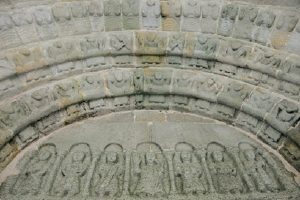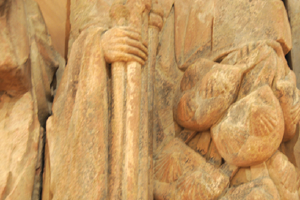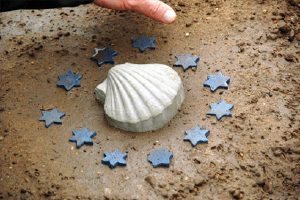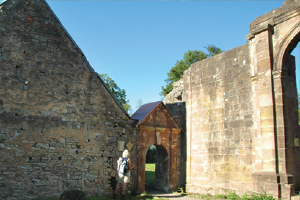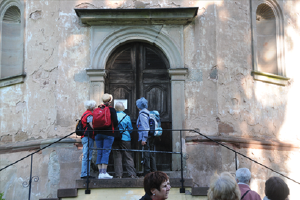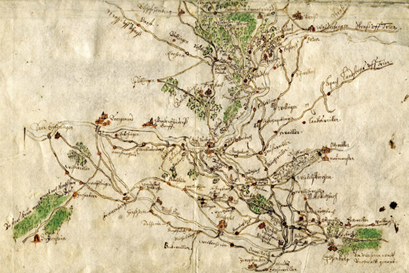Myth of the Way of St. James
A European Cultural Route
For more than a thousand years, the paths of the pilgrims of St. James have attracted travelers from all over the world across the European routes to the burial place of the Apostle James in Santiago de Compostela. Already in the Middle Ages, starting and gathering points for St. James pilgrims were formed in today’s Saar-Lor-Lux and Alsace region, because several significant routes crossed here. The paths of the pilgrims of St. James have not lost their attraction to this day. Today more than ever, people derive joy of life from the spiritual experiences they gain during the pilgrimage on the “Starry Paths” and in the encounters along the way with the diverse cultural landscapes.
The entire network of paths of the pilgrims of St. James branches organically throughout Europe on about 100,000 kilometers.
Routes of the pilgrims of St. James through Europe (official map of the Council of Europe)
Destination of longing - Santiago de Compostela
Since the 9th century, the longing destination of all pilgrims to St. James has been Santiago de Compostela with the tomb of the apostle James. He is said to have been a missionary on the Iberian Peninsula and, after his beheading in Jerusalem by Herod, was transferred to Spain around the year 44. There are many variations on the discovery of the tomb, which was thought to have been lost. According to one version, the tomb was discovered around 813 by a hermit, who was guided by stars, on the Campus Stellae (Latin for Field of Stars) in Galicia. However, the discovery of the tomb on the Iberian Peninsula in Galicia and the pilgrimage movement it triggered can only be read in the context of the reconquest that began in the 8th century, the so-called Reconquista. The Arabs from North Africa, the Moors, had conquered this part of Spain, which already belonged to the Christian Visigoth Empire, in a single battle in 711. This “Holy War” overshadowed Spain and the Pilgrimage of St. James for 800 years until the year 1492.
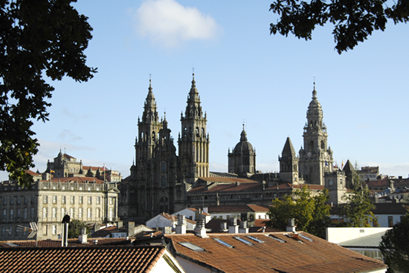
“Starry Path” - “Caminus Stellarum”
The use of the star as the central symbol of the cult of St. James, along with the conch, is historically inspired: In the starry sky, on clear nights, one sees a ribbon-like arm of our spiral galaxy, commonly referred to as the Milky Way. It describes an arc that stretches across Europe from northeast to southwest, pointing to Spain. In the Middle Ages, it was also seen as a cosmic reference to the Tomb of St. James. Many Galicians still refer to the “Milky Way” when speaking of the “Camino”. Alternative names such as “Caminus Stellarum” or “Camino de las estrellas” have been known for the Camino since the Middle Ages.
In various traditions, reference is made to this connection of the Way of St. James to the guiding stars: Charlemagne, for example, is said to have appeared in a dream the apostle James and a path marked by stars to the tomb of the saint.

Scallop - attribute of the apostle
The scallop shell has been the central attribute of the apostle James since the Middle Ages. The messenger of faith is recognized by it, as are all pilgrims following in his footsteps. “Pecten Maximus” is the name for this flat shell from the European Atlantic coast, which can be seen as a scallop shell in depictions of St. James pilgrims and was brought home from Santiago de Compostela from the 12th century at the latest. At the same time, it is the most important symbolic attribute in the medieval representations of St. James.
Artisanal reductions of the scallop shell, e.g., made of gagat, a semi-precious stone of fossilized wood, were also strung on strings and carried along on the pilgrimage or brought back from the pilgrimage as devotional objects. Such agate beads with scallop shells were found in a medieval burial in the collegiate church of Saarbrücken. The equipment of a medieval pilgrim of St. James also included a weather coat, the so-called pelerine, a wide-brimmed hat, a pilgrim’s staff and a drinking bottle, the so-called Gurde. The scallop shell carried along could also be used to draw drinking water.
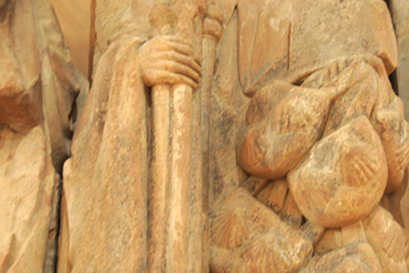
Spirituality - ways of knowledge and initiation
A pilgrimage to Santiago de Compostela has always been a path of knowledge and initiation into nature and the spiritual world. Walking the European paths of the St. James pilgrims is still one of the great cross-border and unifying experiences in Europe. Against this background, the paths of the St. James pilgrims today also stand for the spiritual roots of Europe. Every year, around 800,000 people from Germany alone set out on the paths towards Santiago de Compostela.

